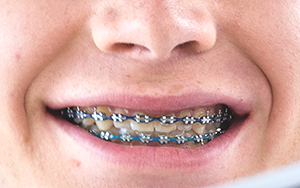Orthodontics/Braces
What is orthodontics?
Orthodontics is the dental specialty that focuses on the diagnosis, prevention, and correction of irregularities of the teeth, bite, and jaws. Orthodontists also have special training in facial problems and jaw disorders. You may see an orthodontist after getting a referral from your general dentist. Your dentist may advise orthodontic treatment to improve your bite and the appearance of your face and teeth. The American Association of Orthodontists advises that every child have an orthodontic evaluation by age 7.

Why choose orthodontic treatment?
Any orthodontic problem may be classified as a malocclusion. This means "bad bite." Orthodontic treatment can help these problems:
-
Misaligned, crooked, or crowded teeth
-
Missing teeth
-
Extra teeth
-
An overbite
-
An underbite
-
An open bite
-
Misaligned or incorrect jaw position
-
A disorder of the jaw joint
-
Open spacing between teeth, including diastema correction
-
Closed-spacing, overlapping, or crowding of teeth
-
Incorrect cross-arch overlapping or crossbite of teeth
Correcting these problems can help create a nice smile. It can also prevent tooth decay, gum disease, tooth loss, speech issues, difficulty chewing, and jaw problems.
At what age are braces appropriate?
Moving and correcting the alignment of the teeth follows the same process no matter what the age. But an adult mouth must overcome already positioned facial bones and jaw structure. Overcoming most types of bite problems may need more than one type of orthodontic treatment for adults. In most cases, the ideal age for braces and other orthodontic treatments is between 8 and 14 years of age. But people with healthy teeth of any age can be helped with treatment.
What are the different types of orthodontic appliances?
Braces are also called fixed orthodontic appliances. They generally come in 3 types:
-
Brackets, metal or plastic, clear or tooth-colored, that are bonded to teeth
-
Lingual-type brackets that attach to the back of teeth, hidden from view
-
Metal bands that wrap around and cover most of the teeth
All 3 types use wires to move the teeth to the desired position.
Another type of orthodontic device that can be used is aligner therapy. Aligners are removable, custom-formed plastic guides that fit over the teeth. They are used in a series to move teeth to their desired positions. Clear aligners are sometimes called invisible braces. Not all orthodontic problems can be treated with clear aligners.
Oral healthcare and braces
The following tips will help eliminate, or reduce, any oral health problems while your teeth are in braces:
-
Brush your teeth carefully at least twice a day with fluoride toothpaste and a soft-bristled toothbrush. Also brush after eating, because food becomes easily stuck in the braces. A new toothbrush may be needed every 3 to 4 months or sooner if bristles are broken or frayed. A worn toothbrush doesn't do a good job of cleaning the teeth.
-
Floss daily between the teeth and the braces. You may need a floss threader to guide the floss under the wire.
-
See an oral health professional for cleanings every 6 months or more often if directed.
-
Limit your sugar and starch intake. Debris left behind from these types of foods may turn into damaging acids. These promote tooth decay and white spots around the braces.
-
Stay away from hard and sticky snacks that may be difficult to remove from the orthodontic equipment in your mouth. This includes hard foods, such as popcorn, hard candy, nuts, and ice chips, and sticky foods like chewing gum, caramel, and other chewy candy.
Ask your dentist about using a fluoride treatment around the braces. This can reduce white spots on the teeth (caused by repeated attacks from plaque acids) after the braces come off.
Online Medical Reviewer:
Jessica Gotwals RN BSN MPH
Online Medical Reviewer:
Michael Kapner MD
Online Medical Reviewer:
Rita Sather RN
Date Last Reviewed:
1/1/2023
© 2000-2024 The StayWell Company, LLC. All rights reserved. This information is not intended as a substitute for professional medical care. Always follow your healthcare professional's instructions.